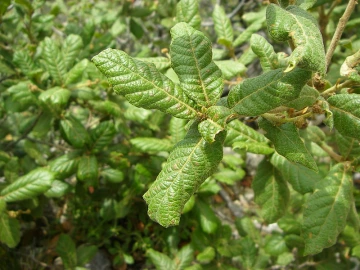
Anthony Mendoza Flickr.com
Botanical Family: Fagaceae
Scientific Name: Quercus rugosa
Common Names: netleaf oak
Botanical Description:
Quercus rugosa is a medium to large size, evergreen to sub-evergreen tree, reaching heights of 10 to 30 meters at maturity, with a rounded crown, and often grows as a tall shrub (1,2). The bark is light gray or brown in color, and scaly, initially thin, with apparent lenticels, later developing longitudinal fissures, and scaly ridges (3,4). Young branches are tomentose, variably pubescent, or glabrous, reddish-brown in color initially, and become gray with age (1,3,4). The rough, leathery leaves are 2-10 cm long, simple, elliptic, or fiddle-shaped, obovate, or oblanceolate, and usually cupped, strongly concave, with revolute margins and 3-9 mucronate or finely pointed teeth (1,2,3). The midvein and 8-12 secondary veins are very prominent, with many smaller veins forming a reticulate or net-like pattern of venation that is characteristic of this species (1,2,3). The upper side of the leaf is lustrous and dark green in color, while the lower side is golden yellow, with a variable covering of stellate, glandular hairs which persist for about 1 year (1). The wind-pollinated flowers are monoecious and borne in spring (1,4). Staminate flowers are long, drooping catkins that are yellow green in color, with reduced or absent petals, and 3-6 stamens; pistillate flowers are solitary or in clusters of 3 or more on very small spikes borne at the leaf axils as the leaves emerge (1,4). After pollination, the pistillate flowers develop into woody cupules that enclose or subtend up to ½ of the fruit (1). The fruit are 1.5-2 cm long, oblong acorns with a hemispheric or bowl-shaped, warty cap; The acorns ripen in early Autumn (1,4). The cotyledons of this species are distinctive, having strikingly reddish or purple flesh (3,5).
Ecological Significance:
Quercus rugosa is typically found in oak-conifer forest communities at an elevation of 5,000 to 9,000 feet (1). It is considered to be one of the most widely distributed species of Mexican oak and is found in 27 of the 32 Mexican states (2,5). This species grows best in climates with hot summers; it is drought tolerant and cold hardy to at least -18° C (5,8). It is known to hybridize readily with other species of oak, and especially the white oak group, including Quercus arizonica and Quercus grisea, with hybrid features being intermediate between the parent species (5). Oaks (Quercus spp.) are keystone species, supporting important food chains and ecological processes. They provide sustenance and shelter for a multitude of animals, plants, fungi, and insects (6,7). Their shade canopy and root systems support soil microbes and invertebrates as well (6,7).
Ethnobotanical Value:
Quercus spp. are important medicinal plants widely used in traditional medicine (1,8,9). Nearly all parts of the plants, including fruit, bark, and leaves, possess medicinal properties. Indigenous tribes used these plants as an antiseptic, and for treatment of gastrointestinal tract disorders (9). The bark, which is rich in tannins, is prepared as a tea for internal use, or an ointment for topical application, purportedly has antiseptic properties, and is used as a blood-clotting agent, and in the treatment of toothaches, inflammation, diarrhea, dysentery, hemorrhages, and burns (8,9,11). However, further research is needed to confirm these benefits and identify all possible side effects of use (10,11). The fruit is a rich source of nutrients, containing high levels of carbohydrates, proteins, amino acids, lipids, and sterols (8,9).
Distribution:
Arizona, New Mexico, Texas, Mexico, and Central America (Gautemala)

